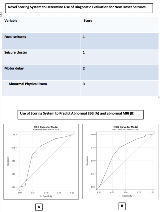Appraisal of a Clinical Scoring System for Neurodiagnostic Evaluation of Patients Presenting With New Onset Seizures to the Pediatric Emergency Department
Abstract number :
1.205
Submission category :
4. Clinical Epilepsy / 4B. Clinical Diagnosis
Year :
2018
Submission ID :
499248
Source :
www.aesnet.org
Presentation date :
12/1/2018 6:00:00 PM
Published date :
Nov 5, 2018, 18:00 PM
Authors :
Nitish Chourasia, McGovern Medical School; Christie Becu, McGovern Medical School; Liang Zhu, McGovern Medical School; Robert Lapus, McGovern Medical School; and Gretchen Von Allmen, McGovern Medical School
Rationale: Seizures occur in approximately 1% of all children up to the age of 14 years, often leading to emergency department (ED) admissions. Patients with new onset unprovoked seizures can be determined to be at risk for epilepsy based on abnormal Electroencephalogram (EEG) and MRI brain. EEG is recommended as part of evaluation of the child with an apparent first unprovoked seizure (AAN practice parameter). There is insufficient evidence to support a recommendation for the use of routine neuroimaging. We assess factors predicting inpatient evaluation of patients presenting with new onset seizures to our pediatric ED and propose a clinical scoring system to effectively identify patients with abnormal neurodiagnostic evaluation including EEG and MRI. Methods: A retrospective study of 233 patients presenting with new onset seizures to the ED were evaluated between 2014-2016. Data regarding age, sex, seizure type, seizure cluster, duration of seizures, physical examination, laboratory evaluation, computed tomography (CT) head, MRI brain, EEG and length of stay were obtained. Statistical analysis used included generalized linear model with binomial distribution and log link to study the association between each candidate factor and the outcomes such as inpatient admission and initiation of anti-epileptic treatment were evaluated. Receiver operating characteristic curve was plotted to assess the utility of diagnostic tests and to measure the utility of a scoring system from the previously elucidated clinically significant parameters. Results: Mean age of patients was 5.68±5.69 with 130 males and 103 females. Out of 233 patients, 122 (52.3%) were admitted to the hospital. Average length of stay for patients getting MRI was 2.3 days and for EEG only was 1.3 days. Factors positively predicting inpatient hospital admission included age, family history of seizures, motor delay, speech delay, seizure cluster, abnormal physical examination, focal seizure and patients receiving abortive medication (p<0.01). Twenty-eight (12%) patients were started on anti-epileptic treatment and levetiracetam was the most commonly initiated medication in 19 (68%) patients. Receiver operating characteristics (ROC) curve for an abnormal EEG predicting treatment was 79.2%. A scoring system incorporating focal seizure (score 1), seizure cluster (score 1), motor delay (score 2), and abnormal physical exam (score 3) with an aggregate score >=2 (by max. Youden criteria) predicted an abnormal EEG with a sensitivity: 76.32%, specificity 61.54% and an abnormal MRI with a sensitivity: 73.53%, specificity 60.3%. Conclusions: Our clinical scoring system for evaluation of patients presenting with new onset seizures to the ED can be effectively used to optimize inpatient evaluation with EEG and MRI and help in early identification of patients at risk for epilepsy. Funding: Not applicable

.tmb-.png?Culture=en&sfvrsn=34a275e3_0)